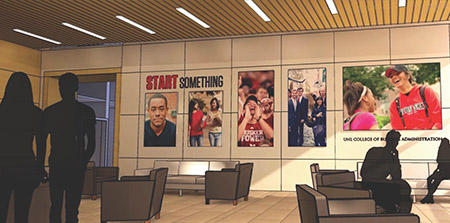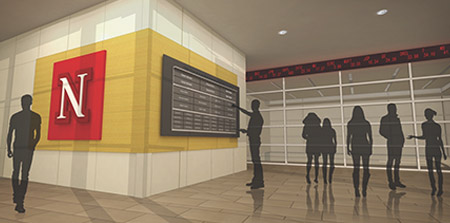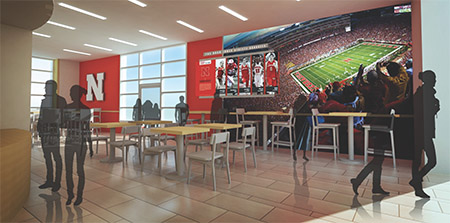Dr. Donde Plowman, executive vice chancellor and chief academic officer for academic affairs, describes the investment of $84 million in the new 240,000-square-foot University of Nebraska–Lincoln College of Business Administration building as a game changer for the college. Now set to open in the summer of 2017, the experiential learning spaces and high-tech classrooms increase opportunities for students, faculty and alumni to maximize teaching and learning.
“To be competitive in the Big Ten our facilities needed a major upgrade,” said Plowman. “Our new building is being funded entirely by donations from our alumni for future alumni. This is a transformational project, and is an extension of everyone who contributes to our college.”
The new 1,689-square-foot Husker Lab gives Nebraska students a one-of-a-kind, hands-on learning environment. Rik Barrera, assistant dean and chief operating officer, believes the lab is a great example of how the new building will impact student learning.
 Student Lounge
Student Lounge
“We couldn’t find other schools doing anything like what will be happening in the Husker Lab,” said Barrera. “In a partnership with the Nebraska Department of Athletics and their merchandiser, Fanatics, our students will sell Husker gear at CBA. They will also manage the store on a day-to-day basis, and Fanatics oversees the operation. There is zero financial risk on our part but great reward with student involvement.”
Beyond running the retail shop, the lab gets access to Fanatics sales data. Rob Simon, associate professor of practice of marketing, is already working with students to ramp up the business. He explained how the integration of Fanatics data into college curriculum gives CBA students direct insight into a real business.
“This is the perfect environment to learn about real business challenges,” said Simon. “Real-time Fanatics sales data will be shared across the college for use in projects for all majors. Management students can look at personnel and governance issues, finance students can study the financial statements and certainly there will be supply chain issues. This is something our students can use on their résumés to differentiate themselves when looking for jobs. We also want to engage with alumni and parents as we integrate this new business with Husker merchandising.”
 Lobby and Trade
Lobby and Trade
The Trade Room is another new high-tech space for students. Dr. Donna Dudney, associate dean for undergraduate programs and student engagement, sees it as a gateway for students to experience what it is like to work in the finance industry.
“It is set up as a hypothetical stock trading room,” said Dudney. “Our students trade stocks of about $100,000 as part of a simulated computerized platform. In addition to having the stock ticker going around the classroom, we will have 12 Bloomberg terminals for students to analyze stock data. Most big brokerage houses and investment banks use these terminals, and the Trade Room design is more conducive to getting students up to speed.”
Finance students on the Chartered Financial Analyst (CFA) track also benefit from using the Trade Room for a two semester practicum in which they manage the Cornhusker Fund. Gifted to the college in the mid-80s, the fund allows students to learn the intricacies of managing a portfolio.
“The ability for students to interact will be a lot better,” said Dr. Richard DeFusco, professor of finance. “We are cramped in our current space, and the arrangement of the room makes group work complicated. Students will be better able to work with each other in the Trade Room and the distribution of Bloomberg terminals around group tables will improve teamwork and communication.”
The new building provides state-of-the-art cluster classrooms designed for students to comfortably transition between lecture style presentations and small group projects.
“The cluster classrooms are a new design for us,” said Dudney. “One room holds 50 people and another 80. The risers between rows are wide enough for tables holding four to six students. Students have plenty of room to face the instructor and then swivel around for learning activities. Whiteboards are also accessible.”
 Café
Café
A new 800-square-foot café will offer a bigger variety of food than currently offered at CBA. It will be open year round and adjacent to a catering kitchen able to facilitate large gatherings. The new 4,262-square-foot atrium space will host events formerly too big for CBA to hold.
“On a day-to-day basis, there will be some seating with tables and chairs in the atrium where students can study and relax,” said Barrera. “Then we will be able to change the configuration of the room and put round tables for big dinner events for up to 300 people. We can hold career fairs and other events that directly impact our students without having to leave our building.”
Barrera also emphasized the ability to better partner with businesses in the new building.
“We will have 16 conference rooms, whereas we currently have three. There will be greater capacity to have ongoing collaboration between students and businesses. The new building is so essential, because it is creating a business environment where we can embody the spirit of our Start Something slogan in ways that were not possible until now,” he said.
New Building webpage
Published: January 9, 2017